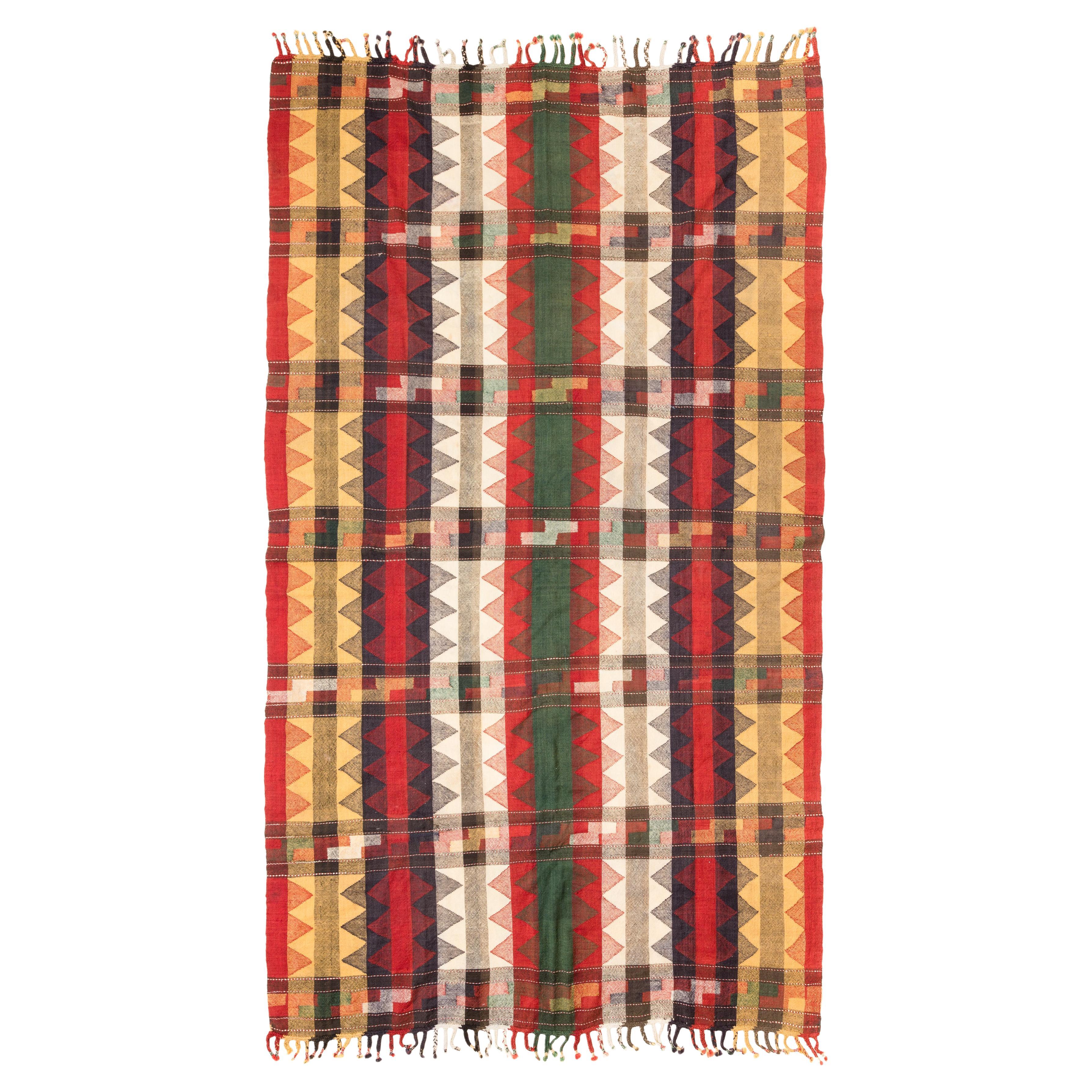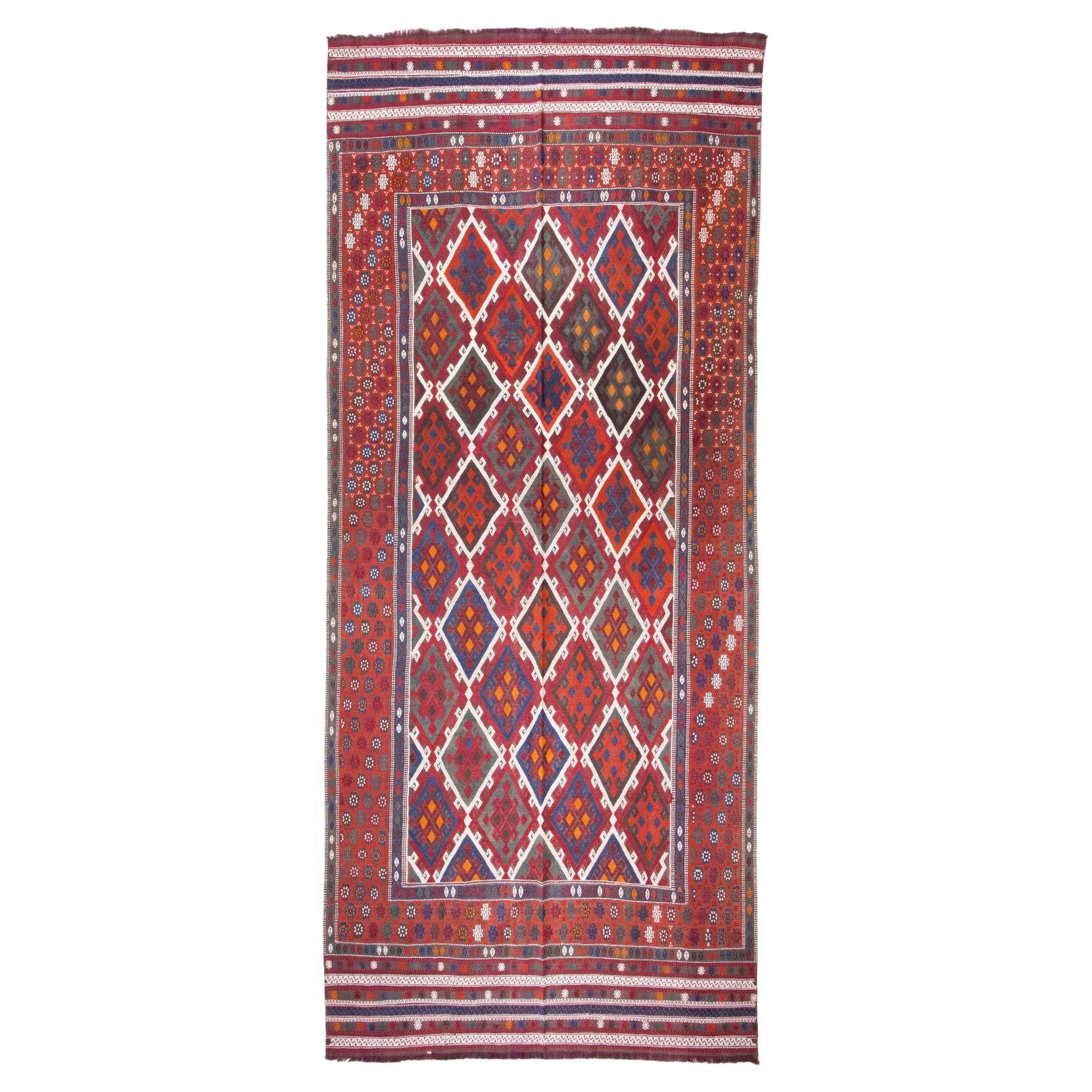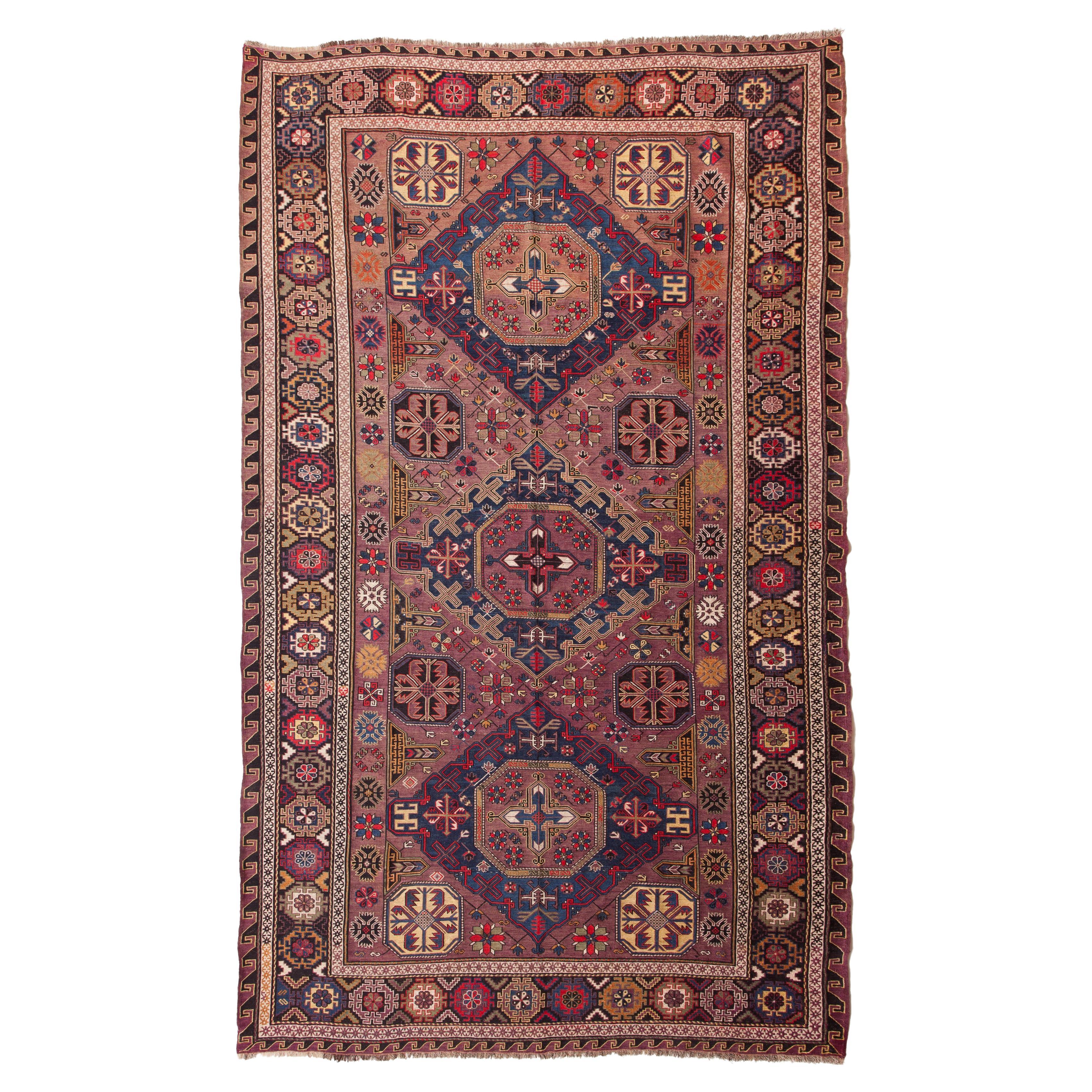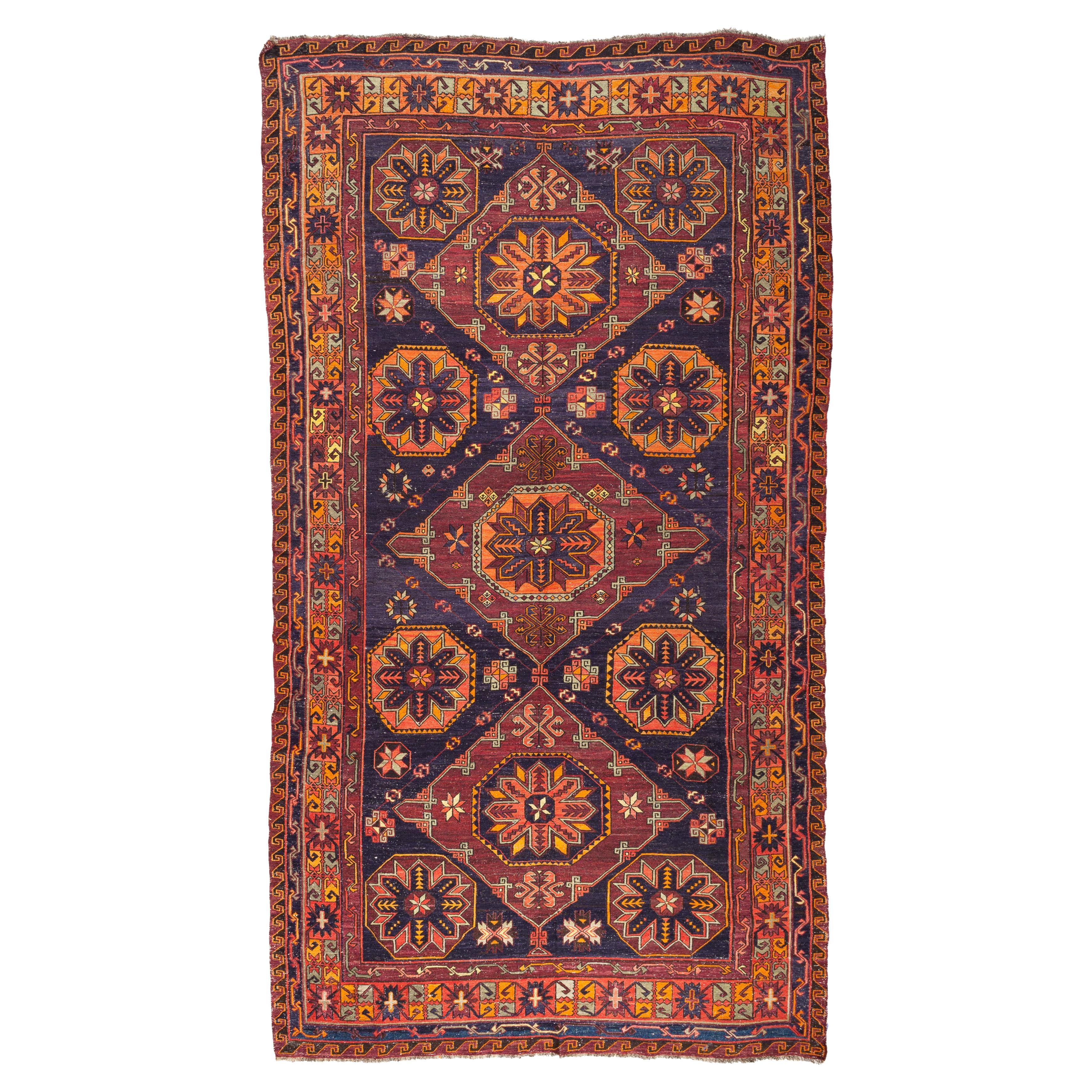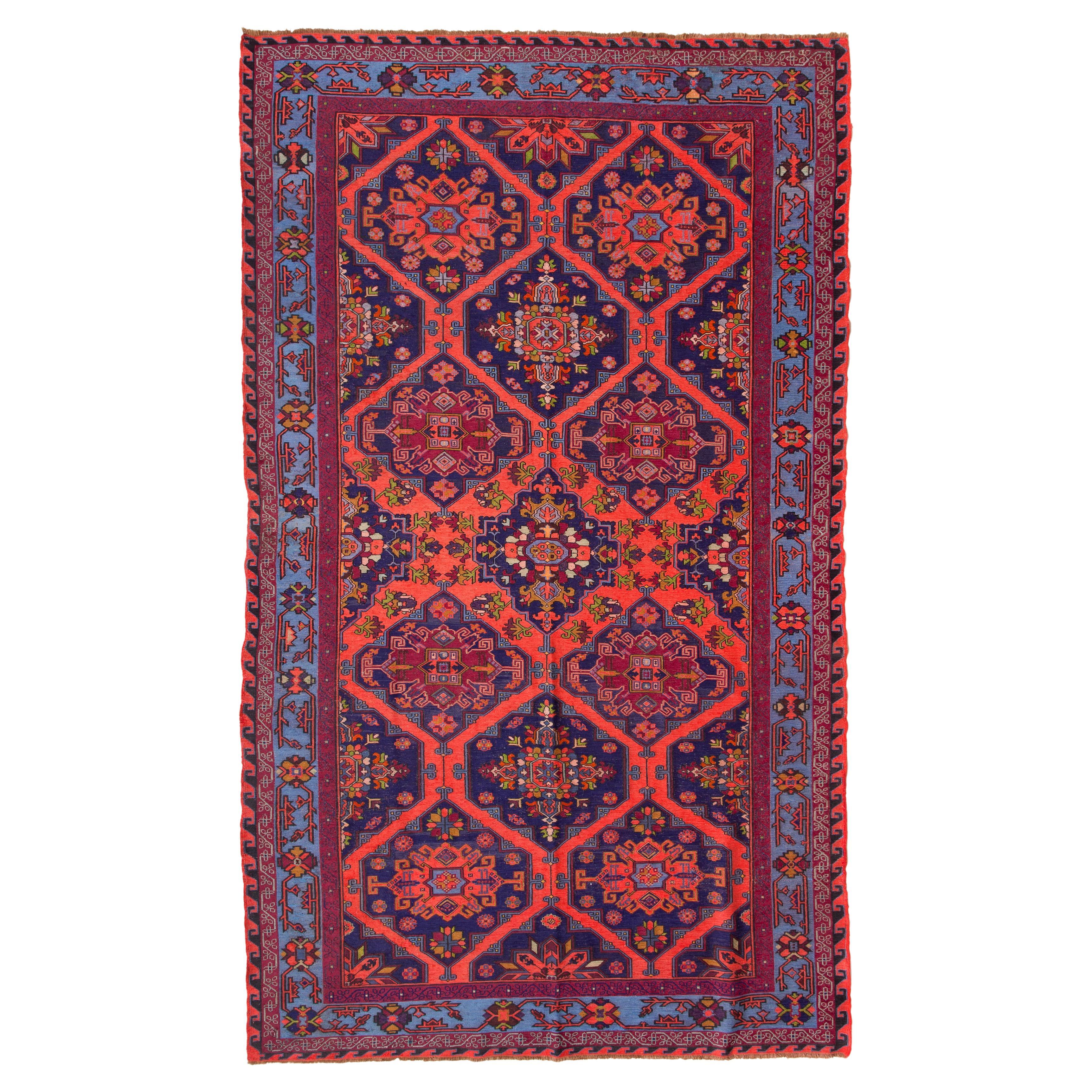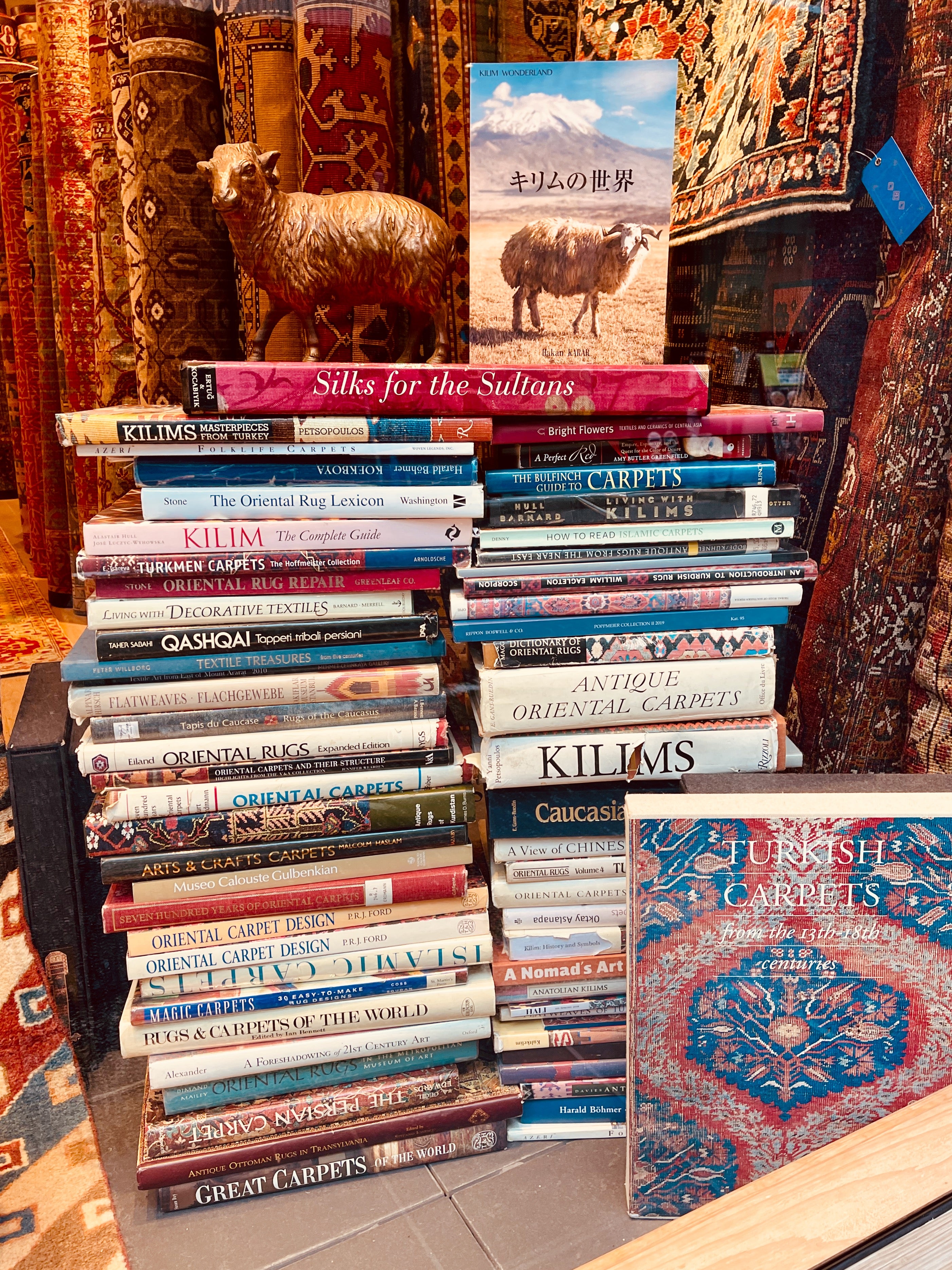Items Similar to Antique Caucasus Talish Kilim Rug, Caucasian Carpet
Want more images or videos?
Request additional images or videos from the seller
1 of 10
Antique Caucasus Talish Kilim Rug, Caucasian Carpet
About the Item
This is a large Antique Talish Kilim from the Caucasus region with a rare and beautiful color composition.
Of the four countries that make up the Caucasus, Azerbaijan produces the most kilims, and the land has a long history of weaving. The nomadic tribes wove kilims and carpets as well as a wide range of storage bags and sacks, such as saffrash, khurgin, and chula, and donkey and horse trappings. Smaller bags for salt, utensils, and other items are also common. Not only are the Azerbaijani weavers prolific, but they also employ many techniques at the loom. These include slitweave- known locally by the word kilim, warp-faced patterning (jajim), supplementary weft (zili), weft wrapping (popularly known as soumak), and extra weft wrapping (verneh). Furthermore, flatweaves are defined by regional names such as palas and shadda, so it is possible to ascribe a variety of weaving names to particular provenances as follows: soumaks are made in Kuba, palas, and kilims in Hajikabul, zili in Khizy, verneh and zili in Kazakh, shadda, verneh and zili in Barda, jajim in Agjabedi, and palas and kilims in Jabrail.
- Dimensions:Width: 66.15 in (168 cm)Length: 131.5 in (334 cm)
- Style:Kilim (In the Style Of)
- Materials and Techniques:
- Place of Origin:
- Period:
- Date of Manufacture:circa 1920s
- Condition:Wear consistent with age and use. Minor structural damages. Minor fading.
- Seller Location:Tokyo, JP
- Reference Number:1stDibs: LU8206238253462
ARARAT RUGS
We know and believe that the geography we come from, our past, and our lifestyle are the most important bond between us to carry the oriental carpet art and culture to the next generations along with our core values in our ongoing growth journey.
We are aware that the way to achieve this goal and carry this priceless art and culture to the future depends on a lot of work with all our people every day while adhering to our core values.
For us, art is meaningful in the sense that it brings together various cultures around the world. It is an honor for us that oriental carpet art and culture have been instrumental in this for centuries and that we are a part of this business.
We are tirelessly keeping an eye on auction house information around the world about carpets. New York's Metropolitan, London's Victoria & Albert Museums, and other famous art museums, as well as small specialized museums that house private collections, and books about oriental carpets to collect information on outstanding carpet designs and patterns from around the world. It's our Self-improving and Self-developing culture.
As Turkish Culture of Hospitality, the Kurdish Culture of Generosity, and as Japanese Culture of Business Punctuality; are the most important values that this multicultural background has taught and bequeathed to us. It is essential and valuable for us that you feel this feeling not only by looking at our oriental carpets but from the moment you contact us.
About the Seller
5.0
Gold Seller
These expertly vetted sellers are highly rated and consistently exceed customer expectations.
Established in 1970
1stDibs seller since 2023
12 sales on 1stDibs
Typical response time: <1 hour
- ShippingRetrieving quote...Ships From: Tokyo, Japan
- Return PolicyA return for this item may be initiated within 7 days of delivery.
More From This SellerView All
- Antique Caucasus Verneh Kilim Rug, Caucasian CarpetLocated in Tokyo, JPThis is a large Antique Verneh Kilim from the Caucasus region with a rare and beautiful color composition. Of the four countries that make up the Caucasus, Azerbaijan produces the most kilims, and the land has a long history of weaving. The nomadic tribes wove kilims and carpets as well as a wide range of storage bags and sacks, such as saffrash, khurgin and chula, and donkey and horse trappings. Smaller bags...Category
Early 20th Century Caucasian Kilim Caucasian Rugs
MaterialsWool, Natural Fiber
- Antique Caucasus Verneh Kilim Rug, Caucasian CarpetLocated in Tokyo, JPThis is a large Antique Verneh Kilim from the Caucasus region with a rare and beautiful color composition. Of the four countries that make up the Caucasus, Azerbaijan produces the...Category
Early 20th Century Caucasian Kilim Caucasian Rugs
MaterialsWool, Natural Fiber
- Antique Caucasus Soumak Kilim Rug, Caucasian CarpetLocated in Tokyo, JPThis is a large Antique Soumak ( Sumak, Sumac ) Kilim from the Caucasus region with a rare and beautiful color composition. Of the four countries that make up the Caucasus, Azerbaijan produces the most kilims, and the land has a long history of weaving. The nomadic tribes wove kilims and carpets as well as a wide range of storage bags and sacks, such as saffrash, khurgin and chula, and donkey and horse trappings. Smaller bags for salt, utensils, and other items are also common. Not only are the Azerbaijani weavers prolific, but they also employ many techniques at the loom. These include slitweave- known locally by the word kilim, warp-faced patterning (jajim), supplementary weft (zili), weft wrapping (popularly known as soumak), and extra weft wrapping (verneh). Furthermore, flatweaves are defined by regional names such as palas and shadda, so it is possible to ascribe a variety of weaving names to particular provenances as follows: soumaks are made in Kuba, palas, and kilims in Hajikabul, zili in Khizy, verneh and zili in Kazakh, shadda, verneh and zili in Barda, jajim in Agjabedi, and palas and kilims in Jabrail. Soumak weave is a technique in which new weft threads are added to a plain weave fabric, and one or two warp threads are wound from the front to the back. The resulting kilim is denser and firmer, giving it a unique feel and look. This technique is commonly used in the Caucasus region. Soumak Kilims have a very beautiful contrast between orange that shines like the sun, deep purple-tinged indigo, and astringent dark red. You can also see the unevenly dyed abrage in this sumac, which is like a magic carpet with an oriental atmosphere. Features of the Caucasian kilim, such as the unique cosmic geometric floral pattern, are also found in this Soumak. It has a bright look, but it also has a faded and textured feel, so it can be used in a good old atmosphere. The woven fabric is particularly solid, so it is recommended for use in a solid living room or under a dining table without moving or twisting. A nice kilim under a long wooden dining table.Category
Early 20th Century Caucasian Kilim Caucasian Rugs
MaterialsWool, Natural Fiber
- Antique Caucasus Soumak Kilim Rug, Caucasian CarpetLocated in Tokyo, JPThis is an Antique Soumak ( Sumak, Sumac ) Kilim from the Caucasus region with a rare and beautiful color composition. Of the four countries that make up the Caucasus, Azerbaijan produces the most kilims, and the land has a long history of weaving. The nomadic tribes wove kilims and carpets as well as a wide range of storage bags and sacks, such as saffrash, khurgin and chula, and donkey and horse trappings. Smaller bags for salt, utensils, and other items are also common. Not only are the Azerbaijani weavers prolific, but they also employ many techniques at the loom. These include slitweave- known locally by the word Kilim, warp-faced patterning (jajim), supplementary weft (zili), weft wrapping (popularly known as soumak), and extra weft wrapping (verneh). Furthermore, flatweaves are defined by regional names such as palas and shadda, so it is possible to ascribe a variety of weaving names to particular provenances as follows: soumaks are made in Kuba, palas, and kilims in Hajikabul, zili in Khizy, verneh and zili in Kazakh, shadda, verneh and zili in Barda, jajim in Agjabedi, and palas and kilims in Jabrail. Soumak weave is a technique in which weft threads are added to a plain weave fabric, and one or two warp threads are wound from the front to the back. The resulting Kilim is denser and firmer, giving it a unique feel and look. This technique is commonly used in the Caucasus region. Soumak kilims have a very beautiful contrast between orange that shines like the sun, deep purple-tinged indigo, and astringent dark red. You can also see the unevenly dyed abrage in this Soumak, which is like a magic carpet with an oriental atmosphere. Features of the Caucasian Kilim, such as the unique cosmic geometric floral pattern, are also found in this Soumak which has a bright look, but it also has a faded and textured feel, so it can be used in a good old atmosphere. The woven fabric is particularly solid, so it is recommended for use in a solid living room or under a dining table without moving or twisting. A nice Kilim under a long wooden dining table.Category
Antique Late 19th Century Caucasian Kilim Caucasian Rugs
MaterialsWool, Natural Fiber
- Old Caucasus Soumak Kilim Rug, Caucasian Sumak CarpetLocated in Tokyo, JPThis is an old Soumak ( Sumak, Sumac ) Kilim from the Caucasus region with a rare and beautiful color composition. Of the four countries that make up the Caucasus, Azerbaijan produces the most kilims, and the land has a long history of weaving. The nomadic tribes wove kilims and carpets as well as a wide range of storage bags and sacks, such as saffrash, khurgin and chula, and donkey and horse trappings. Smaller bags for salt, utensils, and other items are also common. Not only are the Azerbaijani weavers prolific, but they also employ many techniques at the loom. These include slitweave- known locally by the word kilim, warp-faced patterning (jajim), supplementary weft (zili), weft wrapping (popularly known as soumak), and extra weft wrapping (verneh). Furthermore, flatweaves are defined by regional names such as palas and shadda, so it is possible to ascribe a variety of weaving names to particular provenances as follows: soumaks are made in Kuba, palas, and kilims in Hajikabul, zili in Khizy, verneh and zili in Kazakh, shadda, verneh and zili in Barda, jajim in Agjabedi, and palas and kilims in Jabrail. Soumak weave is a technique in which weft threads are added to a plain weave fabric, and one or two warp threads are wound from the front to the back. The resulting kilim is denser and firmer, giving it a unique feel and look. This technique is commonly used in the Caucasus region. Soumak has a very beautiful contrast between orange that shines like the sun, deep purple-tinged indigo, and astringent dark red. You can also see the unevenly dyed abrage in this Soumak, which is like a magic carpet with an oriental atmosphere. Features of the Caucasian kilim, such as the unique cosmic geometric floral pattern, are also found in this Soumak which has a bright look, but it also has a faded and textured feel, so it can be used in a good old atmosphere. The woven fabric is particularly solid, so it is recommended for use in a solid living room or under a dining table without moving or twisting. A nice kilim under a long wooden dining table.Category
Mid-20th Century Caucasian Kilim Caucasian Rugs
MaterialsWool, Natural Fiber
- Old Caucasus Soumak Kilim Rug, Caucasian Sumak CarpetLocated in Tokyo, JPThis is an old Soumak ( Sumak, Sumac ) Kilim from the Caucasus region with a rare and beautiful color composition. Of the four countries that make up the Caucasus, Azerbaijan produces the most kilims, and the land has a long history of weaving. The nomadic tribes wove kilims and carpets as well as a wide range of storage bags and sacks, such as saffrash, khurgin and chula, and donkey and horse trappings. Smaller bags for salt, utensils, and other items are also common. Not only are the Azerbaijani weavers prolific, but they also employ many techniques at the loom. These include slitweave- known locally by the word kilim, warp-faced patterning (jajim), supplementary weft (zili), weft wrapping (popularly known as soumak), and extra weft wrapping (verneh). Furthermore, flatweaves are defined by regional names such as palas and shadda, so it is possible to ascribe a variety of weaving names to particular provenances as follows: soumaks are made in Kuba, palas, and kilims in Hajikabul, zili in Khizy, verneh and zili in Kazakh, shadda, verneh and zili in Barda, jajim in Agjabedi, and palas and kilims in Jabrail. Soumak weave is a technique in which weft threads are added to a plain weave fabric, and one or two warp threads are wound from the front to the back. The resulting kilim is denser and firmer, giving it a unique feel and look. This technique is commonly used in the Caucasus region. Soumak has a very beautiful contrast between orange that shines like the sun, deep purple-tinged indigo, and astringent dark red. You can also see the unevenly dyed abrage in this Soumak, which is like a magic carpet with an oriental atmosphere. Features of the Caucasian kilim, such as the unique cosmic geometric floral pattern, are also found in this Soumak which has a bright look, but it also has a faded and textured feel, so it can be used in a good old atmosphere. The woven fabric is particularly solid, so it is recommended for use in a solid living room or under a dining table without moving or twisting. A nice kilim under a long wooden dining table.Category
Mid-20th Century Caucasian Kilim Caucasian Rugs
MaterialsWool, Natural Fiber
You May Also Like
- Antique Caucasian Rug - Rare Caucasian Carpet, Caucasus Rug, Antique RugLocated in Sultanahmet, 34Rare Caucasian Rug Caucasus Rug Size: 176×224 cm This wonderful rug is a formerly unpublished addition to a small and rare group of blue-ground Caucasian rugs whose design is dominated by a prominent decahedral gabled ivory medallion. The overall pattern echoes that of a group of earlier 17th and 18th century north west Persian carpets, whose designs were based upon the Persian garden plan known as the “Four Gardens” or Chahar Bagh (M.S.Dimand & J. Mailey, Oriental Rugs in the Metropolitan Museum of Art, New York, 1973, p.84, fig.116). The smaller lozenges that extend above and below the central medallion on the present lot, are linked by a narrow vertical channel which represents the streams and ornamental pools that feed the flowering trees and shrubs on either side. The once eight-pointed medallion, that is an archaic form found in early Anatolian and Caucasian rugs, and which continues to be used throughout the nineteenth century in Fachralo rugs...Category
Antique 19th Century Caucasian Caucasian Rugs
MaterialsWool
- Antique Caucasian Talish Rug - 19th Century South East Caucasus Rug, Antique RugLocated in Sultanahmet, 34Caucasian Talish Rug Caucasus Rug South East Caucasus, Moghan region Talish Rug Second half 19th Century South East Caucasus, Moghan region Talish Rug A rare Moghan woven in a long...Category
Antique 19th Century Caucasian Caucasian Rugs
MaterialsWool
- Antique Caucasian Talish RugLocated in New York, NYBeautifully aged Talish rug hand-knotted in the late 19th-early 20th century. The design features a central field in a bold red hue, framed by a series of b...Category
Antique Late 19th Century Caucasian Caucasian Rugs
MaterialsWool
- Antique Caucasian, Talish Rug 3' 0'' x 9' 5''Located in New York, NYAntique Caucasian - Talish rug, size: 3' 0'' x 9' 5''.Category
Antique Early 1900s Caucasian Caucasian Rugs
MaterialsWool
- Antique Caucasian-Talish RugLocated in New York, NYAntique Caucasian-Talish rug, size: 3'4" x 7'0".Category
Antique 1880s Caucasian Caucasian Rugs
MaterialsWool
- Antique Caucasian-Talish RugLocated in New York, NYAntique Caucasian-Talish rug 3, measures: '6" x 8'8".Category
Antique 1890s Caucasian Caucasian Rugs
MaterialsWool
